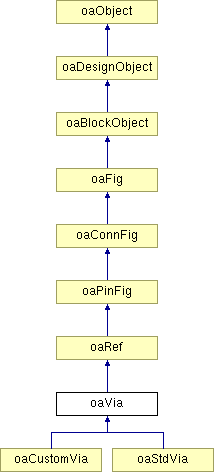oaVia Class Reference
Inheritance diagram for oaVia:

Detailed Description
The oaVia class is an abstract base class for vias. A via represents a physical connection between two adjacent route pathSegs that are on different layers. A via references a via definition (oaViaDef) from the technology database that corresponds to the design where the via exists.
A via may be either a standard via or a custom via. A standard via has a pre-defined set of via parameters that can be tailored to create a variety of vias to cover a variety of connections. The standard via references a standard via definition.
A custom via is very much like an instance where, through its custom via definition, another design is referenced. Custom vias often include a set of parameter values that can be used to tailor the master for each specific via.
A via can represent complex pin figures although vias are normally associated with routes.
Vias always have an oaViaHeader which contains the attributes that are constant for all vias of a given via definition.
The oaVia class can be observed by deriving from oaObserver<oaVia>.
A discussion of the creation of oaVia objects can be found in the Representing Vias in OpenAccess section of the Programmers Guide.
Member Function Documentation
|
|
This function returns a collection of routes that are connected to this via. Each route in the collection has this via as either its startConn, endConn, or both. |
|
|
This function returns the direction of this via. |
|
|
This function returns the oaViaHeader associated with this via. The oaViaHeader is a collection of the attributes that are common to all vias of a particular via definition. For vias of via definitions that have parameters, this function returns the via subheader.
- Returns:
- The pointer to the via header
Reimplemented from oaRef.
Reimplemented in oaStdVia, and oaCustomVia. |
|
|
This function returns the purpose number associated with this via. |
| oaRoute * oaVia::getRoute |
( |
|
) |
const |
|
|
|
This function returns the route to which this via may belong. If this via does not belong to a route, a NULL is returned. |
|
|
This function returns the current routing status of this via. |
|
|
This function returns the current routing topology of this via. |
| oaBitNet * oaVia::getShieldedNet1 |
( |
|
) |
const |
|
|
|
This function returns the first net that this via is shielding. A via may shield up to two nets. |
| oaBitNet * oaVia::getShieldedNet2 |
( |
|
) |
const |
|
|
|
This function returns the second net that this via is shielding. A via may shield up to two nets. |
|
|
This function returns the oaViaDef object associated with this via. If the oaViaDef is not bound, a NULL is returned. |
| void oaVia::getViaDefName |
( |
oaString & |
name |
) |
const |
|
|
|
This function fills out name with the name of the via definition associated with this via. |
|
|
This function returns true if this via is part of a route, false otherwise. |
|
|
This function returns true if this via is not shielded. |
|
|
This function sets the direction of this via to the specified 'dir'.
- Parameters:
-
| dir | The direction to be set for this via |
|
|
|
This function sets the purpose of this via to the specified 'purposeNum' value.
- Parameters:
-
| purposeNum | The new technology purpose number to associate with this via |
|
|
|
This function sets the routeStatus of this via to the specified 'status'.
- Parameters:
-
| status | The routing status to be set for this via |
|
|
|
This function sets the routeTopology of this via to the specified 'topology'.
- Parameters:
-
| topology | The routing topology to be set for this via |
|
| void oaVia::setShieldedNet1 |
( |
oaBitNet * |
net |
) |
|
|
|
|
This function sets the first shielded net for this via to the specified bit net. A via may shield up to two nets. A NULL pointer resets the attribute. Exceptions are thrown if the bit net is not in the same database as this via.
- Parameters:
-
| net | Bit net that is shielded by this via |
- Exceptions:
-
|
| void oaVia::setShieldedNet2 |
( |
oaBitNet * |
net |
) |
|
|
|
|
This function sets the second shielded net for this via to the specified bit net. A via may shield up to two nets. A NULL pointer resets the attribute. Exceptions are thrown if the bit net is not in the same database as this via.
- Parameters:
-
| net | Bit net that is shielded by this via |
- Exceptions:
-
|
| void oaVia::setUnShielded |
( |
oaBoolean |
unShielded |
) |
|
|
|
|
This function sets the unShielded attribute of this via to the specified value.
- Parameters:
-
|
Member Enumeration Documentation
The documentation for this class was generated from the following files:
Return to top of page
Copyright © 2002 - 2010 Cadence Design Systems, Inc.
All Rights Reserved.






